Exploring the Coupling Coordination and Key Factors between Urban–Rural Integrated Development and Land-Use Efficiency in the Yellow River Basin
Abstract
1. Introduction
2. Study Area and Indicator System
2.1. Study Area and Data Sources
2.2. Design of the Evaluation Indicator System
3. Methods
3.1. The Linear Weighting Method for Measuring the Level of Integrated Urban–Rural Development
3.2. The Super-Efficiency SBM Model for Measuring Land-Use Efficiency (LUE)
3.3. The Coupled Coordination Degree (CCD) Model for Evaluating the Coupling Coordination Level of Urban–Rural Integrated (URI) Development and LUE
3.4. The Non-Parametric Kernel Density Estimation to Reflecting the Temporal Pattern of CCD
3.5. The Geographic Detector for Identifying Key Factors
4. Analysis of Results
4.1. Evolution of Spatial and Temporal Patterns of Integrated Urban–Rural Development
4.2. Evolution of Spatial and Temporal Patterns of LUE
4.3. Evolution of Spatial and Temporal Patterns of Coupled Coordination
4.4. Analysis of Influencing Factors
5. Discussion
5.1. Strengthening Policy Support Is Conducive to Urban and Rural Areas’ Comprehensive, Integrated Development and Improving LUE
5.2. The Economic and Intensive Use of Land Resources Is Conducive to the Simultaneous Development of Urban–Rural Integration and Land-Use
5.3. High-Quality Economic Development, Rational Urbanization Development, and High-End Green Transformation of Industries Increase the CCD between URI Development and LUE
6. Conclusions
Author Contributions
Funding
Data Availability Statement
Conflicts of Interest
References
- Shan, B.; Zhang, Q.; Ren, Q.; Yu, X.; Chen, Y. Spatial heterogeneity of urban–rural integration and its influencing factors in Shandong province of China. Sci. Rep. 2022, 12, 14317. [Google Scholar] [CrossRef]
- Liu, Y.; Li, Y. Revitalize the world’s countryside. Nature 2017, 548, 275–277. [Google Scholar] [CrossRef] [PubMed]
- Song, W.; Cao, S.; Du, M.; Lu, L. Distinctive roles of land-use efficiency in sustainable development goals: An investigation of trade-offs and synergies in China. J. Clean. Prod. 2023, 382, 134889. [Google Scholar] [CrossRef]
- Song, X.-P.; Hansen, M.C.; Stehman, S.V.; Potapov, P.V.; Tyukavina, A.; Vermote, E.F.; Townshend, J.R. Global land change from 1982 to 2016. Nature 2018, 560, 639–643. [Google Scholar] [CrossRef]
- Zheng, Q.; Jiang, G.; Yang, Y.; Zhou, D.; Qu, Y. Does spatial equilibrium of factor allocation inevitably bring about high benefits for regional development? An empirical study of the Beijing-Tianjin-Hebei region, China. Habitat Int. 2020, 95, 102066. [Google Scholar] [CrossRef]
- Chen, M.; Gong, Y.; Lu, D.; Ye, C. Build a people-oriented urbanization: China’s new-type urbanization dream and Anhui model. Land Use Policy 2019, 80, 1–9. [Google Scholar] [CrossRef]
- Fang, C. On integrated urban and rural development. J. Geogr. Sci. 2022, 32, 1411–1426. [Google Scholar] [CrossRef]
- Xia, F.; Zhang, Z.; Wang, X. Hometown attachment or urban dependence? The reciprocal effects between multi-dimensional relative poverty of migrant workers and urban-rural land dependence. Habitat Int. 2023, 137, 102850. [Google Scholar] [CrossRef]
- Zhou, Y.; Li, X.; Liu, Y. Rural land system reforms in China: History, issues, measures and prospects. Land Use Policy 2020, 91, 104330. [Google Scholar] [CrossRef]
- Ma, W.; Jiang, G.; Chen, Y.; Qu, Y.; Zhou, T.; Li, W. How feasible is regional integration for reconciling land use conflicts across the urban–rural interface? Evidence from Beijing–Tianjin–Hebei metropolitan region in China. Land Use Policy 2020, 92, 104433. [Google Scholar] [CrossRef]
- Liu, Y.; Fang, F.; Li, Y. Key issues of land use in China and implications for policy making. Land Use Policy 2014, 40, 6–12. [Google Scholar] [CrossRef]
- Niu, B.; Ge, D.; Sun, J.; Sun, D.; Ma, Y.; Ni, Y.; Lu, Y. Multi-scales urban-rural integrated development and land-use transition: The story of China. Habitat Int. 2023, 132, 102744. [Google Scholar] [CrossRef]
- Chen, K.; Long, H.; Liao, L.; Tu, S.; Li, T. Land use transitions and urban-rural integrated development: Theoretical framework and China’s evidence. Land Use Policy 2020, 92, 104465. [Google Scholar] [CrossRef]
- Herberholz, C.; Phuntsho, S. Social capital, outpatient care utilization and choice between different levels of health facilities in rural and urban areas of Bhutan. Soc. Sci. Med. 2018, 211, 102–113. [Google Scholar] [CrossRef] [PubMed]
- Potter, R.B.; Unwin, T. Urban-rural interaction: Physical form and political process in the Third World. Cities 1995, 12, 67–73. [Google Scholar] [CrossRef]
- Yang, Y.; Bao, W.; Wang, Y.; Liu, Y. Measurement of urban-rural integration level and its spatial differentiation in China in the new century. Habitat Int. 2021, 117, 102420. [Google Scholar] [CrossRef]
- Ma, L.; Liu, S.; Fang, F.; Che, X.; Chen, M. Evaluation of urban-rural difference and integration based on quality of life. Sustain. Cities Soc. 2020, 54, 101877. [Google Scholar] [CrossRef]
- Lysgård, H.K. The assemblage of culture-led policies in small towns and rural communities. Geoforum 2019, 101, 10–17. [Google Scholar] [CrossRef]
- Rao, J. Comprehensive land consolidation as a development policy for rural vitalisation: Rural In Situ Urbanisation through semi socio-economic restructuring in Huai Town. J. Rural Stud. 2022, 93, 386–397. [Google Scholar] [CrossRef]
- Yang, Y.; Liu, Y.; Li, Y.; Li, J. Measure of urban-rural transformation in Beijing-Tianjin-Hebei region in the new millennium: Population-land-industry perspective. Land Use Policy 2018, 79, 595–608. [Google Scholar] [CrossRef]
- Jiang, C.; Li, J.; Liu, J. Does urbanization affect the gap between urban and rural areas? Evidence from China. Socio-Econ. Plan. Sci. 2022, 82, 101271. [Google Scholar] [CrossRef]
- Zhou, Q.; Shi, W. How does town planning affect urban-rural income inequality: Evidence from China with simultaneous equation analysis. Landsc. Urban Plan. 2022, 221, 104380. [Google Scholar] [CrossRef]
- Silva, R.F.B.D.; Rodrigues, M.D.A.; Vieira, S.A.; Batistella, M.; Farinaci, J. Perspectives for environmental conservation and ecosystem services on coupled rural-urban systems. Perspect. Ecol. Conserv. 2017, 15, 74–81. [Google Scholar] [CrossRef]
- Wang, Y.; Liu, Y.; Li, Y.; Li, T. The spatio-temporal patterns of urban–rural development transformation in China since 1990. Habitat Int. 2016, 53, 178–187. [Google Scholar] [CrossRef]
- Sánchez-Zamora, P.; Gallardo-Cobos, R. Territorial Cohesion in Rural Areas: An Analysis of Determinants in the Post-Economic Crisis Context. Sustainability 2020, 12, 3816. [Google Scholar] [CrossRef]
- Fan, J.; Wang, Q.; Ji, M.; Sun, Y.; Feng, Y.; Yang, F.; Zhang, Z. Ecological network construction and gradient zoning optimization strategy in urban-rural fringe: A case study of Licheng District, Jinan City, China. Ecol. Indic. 2023, 150, 110251. [Google Scholar] [CrossRef]
- Wang, Y.; Peng, Q.; Jin, C.; Ren, J.; Fu, Y.; Yue, X. Whether the digital economy will successfully encourage the integration of urban and rural development: A case study in China. Chin. J. Popul. Resour. Environ. 2023, 21, 13–25. [Google Scholar] [CrossRef]
- Zhou, Y.; Liu, Z.; Wang, H.; Cheng, G. Targeted poverty alleviation narrowed China’s urban-rural income gap: A theoretical and empirical analysis. Appl. Geogr. 2023, 157, 103000. [Google Scholar] [CrossRef]
- Zheng, H.; Wu, Y.; He, H.; Delang, C.O.; Qian, J.; Lu, J.; Yao, Z.; Li, G. Urban land use eco-efficiency and improvement in the western region of China. J. Clean. Prod. 2019, 412, 137385. [Google Scholar] [CrossRef]
- Zhao, J.; Zhu, D.; Cheng, J.; Jiang, X.; Lun, F.; Zhang, Q. Does regional economic integration promote urban land use efficiency? Evidence from the Yangtze River Delta, China. Habitat Int. 2021, 116, 102404. [Google Scholar] [CrossRef]
- Chapin, F.S.; Kaiser, E.J. Urban Land Use Planning; University of Illinois Press: Urbana, IL, USA, 1965. [Google Scholar]
- Gill, S.E.; Handley, J.F.; Ennos, A.R.; Pauleit, S.; Theuray, N.; Lindley, S.J. Characterising the urban environment of UK cities and towns: A template for landscape planning. Landsc. Urban Plan. 2008, 87, 210–222. [Google Scholar] [CrossRef]
- Liu, Y. Research on the urban-rural integration and rural revitalization in the new era in China. Acta Geogr. Sin. 2018, 73, 637–650. [Google Scholar]
- Danni, Z. Land Use Efficiency and its Change of Vietnam Based on DEA. IOP Conf. Ser. Earth Environ. Sci. 2019, 310, 052063. [Google Scholar] [CrossRef]
- Wang, Z.; Fu, H.; Liu, H.; Liao, C. Urban development sustainability, industrial structure adjustment, and land use efficiency in China. Sustain. Cities Soc. 2023, 89, 104338. [Google Scholar] [CrossRef]
- Haller, A. The “sowing of concrete”: Peri-urban smallholder perceptions of rural–urban land change in the Central Peruvian Andes. Land Use Policy 2014, 38, 239–247. [Google Scholar] [CrossRef] [PubMed]
- Masini, E.; Tomao, A.; Barbati, A.; Corona, P.; Serra, P.; Salvati, L. Urban Growth, Land-use Efficiency and Local Socioeconomic Context: A Comparative Analysis of 417 Metropolitan Regions in Europe. Environ. Manag. 2019, 63, 322–337. [Google Scholar] [CrossRef] [PubMed]
- Yu, J.; Zhou, K.; Yang, S. Regional heterogeneity of China’s energy efficiency in “new normal”: A meta-frontier Super-SBM analysis. Energy Policy 2019, 134, 110941. [Google Scholar] [CrossRef]
- He, T.; Song, H. A novel approach to assess the urban land-use efficiency of 767 resource-based cities in China. Ecol. Indic. 2023, 151, 110298. [Google Scholar] [CrossRef]
- Li, S.; Congmou, Z.; Li, Y.; Dong, B.; Tan, K.; Deng, X. Agricultural space function transitions in rapidly urbanizing areas and their impacts on habitat quality: An urban–Rural gradient study. Environ. Impact Assess. Rev. 2023, 99, 107019. [Google Scholar] [CrossRef]
- Serra, P.; Vera, A.; Tulla, A.F.; Salvati, L. Beyond urban-rural dichotomy: Exploring socioeconomic and land-use processes of change in Spain (1991–2011). Appl. Geogr. 2014, 55, 71–81. [Google Scholar] [CrossRef]
- Bittner, C.; Sofer, M. Land use changes in the rural-urban fringe: An Israeli case study. Land Use Policy 2013, 33, 11–19. [Google Scholar] [CrossRef]
- Yin, Q.; Sui, X.; Ye, B.; Zhou, Y.; Li, C.; Zou, M.; Zhou, S. What role does land consolidation play in the multi-dimensional rural revitalization in China? A research synthesis. Land Use Policy 2022, 120, 106261. [Google Scholar] [CrossRef]
- Wu, C.; Wei, Y.D.; Huang, X.; Chen, B. Economic transition, spatial development and urban land use efficiency in the Yangtze River Delta, China. Habitat Int. 2017, 63, 67–78. [Google Scholar] [CrossRef]
- Song, M.; Tao, W. Coupling and coordination analysis of China’s regional urban-rural integration and land-use efficiency. Growth Chang. 2022, 53, 1384–1413. [Google Scholar] [CrossRef]
- Zhou, X.; Yu, J.; Li, J.; Li, S.; Zhang, D.; Wu, D.; Pan, S.; Chen, W. Spatial correlation among cultivated land intensive use and carbon emission efficiency: A case study in the Yellow River Basin, China. Environ. Sci. Pollut. Res. 2022, 29, 43341–43360. [Google Scholar] [CrossRef] [PubMed]
- Wang, X.; Shen, Y.; Su, C. Spatial–temporal evolution and driving factors of carbon emission efficiency of cities in the Yellow River Basin. Energy Rep. 2023, 9, 1065–1070. [Google Scholar] [CrossRef]
- Wei, J.; Lei, Y.; Yao, H.; Ge, J.; Wu, S.; Liu, L. Estimation and influencing factors of agricultural water efficiency in the Yellow River basin, China. J. Clean. Prod. 2021, 308, 127249. [Google Scholar] [CrossRef]
- Xiao, Y.; Zhong, J.-L.; Zhang, Q.-F.; Xiang, X.; Huang, H. Exploring the coupling coordination and key factors between urbanization and land use efficiency in ecologically sensitive areas: A case study of the Loess Plateau, China. Sustain. Cities Soc. 2022, 86, 104148. [Google Scholar] [CrossRef]
- Ge, K.; Zou, S.; Lu, X.; Ke, S.; Chen, D.; Liu, Z. Dynamic Evolution and the Mechanism behind the Coupling Coordination Relationship between Industrial Integration and Urban Land-Use Efficiency: A Case Study of the Yangtze River Economic Zone in China. Land 2022, 11, 261. [Google Scholar] [CrossRef]
- Tone, K. A slacks-based measure of efficiency in data envelopment analysis. Eur. J. Oper. Res. 2001, 130, 498–509. [Google Scholar] [CrossRef]
- Zhu, L.; Zhang, Y.; Zhang, G. A study on coupling coordination and spatio-temporal characteristics of urban land and water resources utilization efficiency in china. Econ. Surv. 2021, 38, 22–30. [Google Scholar]
- Sun, Y.; Tong, L. Spatio-temporal coupling relationship between development strength and eco-environment in the Restricted Development Zone of Northeast China. Sci. Geogr. Sin. 2021, 41, 684–694. [Google Scholar]
- Zhou, X.; Wu, D.; Li, J.; Liang, J.; Zhang, D.; Chen, W. Cultivated land use efficiency and its driving factors in the Yellow River Basin, China. Ecol. Indic. 2022, 144, 109411. [Google Scholar] [CrossRef]
- Liu, Y.; Zang, Y.; Yang, Y. China’s rural revitalization and development: Theory, technology and management. J. Geogr. Sci. 2020, 30, 1923–1942. [Google Scholar] [CrossRef]
- Xi, B.; Li, X.; Gao, J.; Zhao, Y.; Liu, H.; Xia, X.; Yang, T.; Zhang, L.; Jia, X. Review of challenges and strategies for balanced urban-rural environmental protection in China. Front. Environ. Sci. Eng. 2015, 9, 371–384. [Google Scholar] [CrossRef]
- Zhang, Y.; Li, Y.; Chen, Y.; Liu, S.; Yang, Q. Spatiotemporal Heterogeneity of Urban Land Expansion and Urban Population Growth under New Urbanization: A Case Study of Chongqing. Int. J. Environ. Res. Public Health 2022, 19, 7792. [Google Scholar] [CrossRef] [PubMed]
- Sun, P.; Lv, F.; Xiu, C.; Xie, C. Basic Cognition and Evaluation of Urban Economical and Intensive Land Use Under the New Urbanization. Econ. Geogr. 2015, 35, 178–183. [Google Scholar] [CrossRef]
- Dong, Z.; Wei, Y.; Ren, C.; Wang, S. Comprehensive land improvement innovation for rural revitalization:Public value creation and realization. Resour. Sci. 2022, 44, 1305–1315. [Google Scholar]
- Zhang, H.; Wang, Y.; Liu, Y. Integrated urban-rural development and land resource utilization efficiency. Financ. Econ. 2020, 10, 108–120. [Google Scholar]
- Xie, L.; He, R.; Shi, W.; Pu, H. Spatio-temporal Evolution and Dynamic Mechanism of Urban-Rural Integration Develpment in the Yellow River Basin. J. Desert Res. 2022, 42, 31–40. [Google Scholar]
- Wei, L.; Zhao, X.; Lu, J. Measuring the Level of Urban–Rural Integration Development and Analyzing the Spatial Pattern Based on the New Development Concept: Evidence from Cities in the Yellow River Basin. Int. J. Environ. Res. Public Health 2023, 20, 15. [Google Scholar] [CrossRef] [PubMed]
- Berchoux, T.; Hutton, C.W.; Hensengerth, O.; Voepel, H.E.; Tri, V.P.D.; Vu, P.T.; Hung, N.N.; Parsons, D.; Darby, S.E. Effect of planning policies on land use dynamics and livelihood opportunities under global environmental change: Evidence from the Mekong Delta. Land Use Policy. 2023, 131, 106752. [Google Scholar] [CrossRef]
- Woodworth, M.D. Ordos Municipality: A market-era resource boomtown. Cities 2015, 43, 115–132. [Google Scholar] [CrossRef]
- Wang, H.; Qin, M.; Zhang, P. The Study of Land Use Change and Its Driving Force in Zheng Zhou’s Urbanization. Bachelor’s Degree, Henan University, Kaifeng, China, 2017. [Google Scholar]
- Mu, B.; Mayer, A.L.; He, R.; Tian, G. Land use dynamics and policy implications in Central China: A case study of Zhengzhou. Cities 2016, 58, 39–49. [Google Scholar] [CrossRef]
- Shi, J.; Dan, K.; Wu, G.; Li, J.; Xu, K. Efficiency of Urban-rural Integration Development in the Yangtze River Delta Under the Background of Carbon Emission Constraint. Econ. Geogr. 2021, 41, 57–67. [Google Scholar]
- Lacroix, K. Comparing the relative mitigation potential of individual pro-environmental behaviors. J. Clean. Prod. 2018, 195, 1398–1407. [Google Scholar] [CrossRef]
- Chen, J.M. Carbon neutrality: Toward a sustainable future. Innovation 2021, 2, 100127. [Google Scholar] [CrossRef]
- Li, W.; Zhang, S.; Lu, C. Exploration of China’s net CO2 emissions evolutionary pathways by 2060 in the context of carbon neutrality. Sci. Total Environ. 2022, 831, 154909. [Google Scholar] [CrossRef]
- Li, Y. Urban–rural interaction patterns and dynamic land use: Implications for urban–rural integration in China. Reg. Environ. Change 2012, 12, 803–812. [Google Scholar] [CrossRef]
- Bai, X.; Shi, P.; Liu, Y. Society: Realizing China’s urban dream. Nature 2014, 509, 158–160. [Google Scholar] [CrossRef]
- Zheng, Q.; Deng, J.; Jiang, R.; Wang, K.; Xue, X.; Lin, Y.; Huang, Z.; Shen, Z.; Li, J.; Shahtahmassebi, A.R. Monitoring and assessing “ghost cities” in Northeast China from the view of nighttime light remote sensing data. Habitat Int. 2017, 70, 34–42. [Google Scholar] [CrossRef]
- Wu, X.; Ding, J.; Lu, B.; Wan, Y.; Shi, L.; Wen, Q. Eco-environmental effects of changes in territorial spatial pattern and their driving forces in qinghai, china (1980–2020). Land 2022, 11, 1772. [Google Scholar] [CrossRef]
- Liu, Y.; Li, Y. China’s land creation project stands firm. Nature 2014, 511, 410. [Google Scholar] [CrossRef] [PubMed]
- Zhang, L.; Song, Y.; Zhu, D.; Huang, A. Spatial Temporal Pattern Evolution and Influencing Factors of Urban Construction Land Use Efficiency in Yangtze River Economic Belt. Areal Res. Dev. 2020, 39, 154–159. [Google Scholar]
- Liu, Q.; Yan, C.; Zhang, Y.; Yang, J.; Zheng, S. Variation of Precipitation and Temperature in Yellow River Basin during the Last 50 Years. Chin. J. Agrometeorol. 2012, 33, 475–480. [Google Scholar]
- Chang, J.; Wang, Y.; Zhao, Y.; Li, F. Characteristics of Climate Change of Precipitation and Rain Days in the Yellow River Basin during Recent 50 Years. Plateau Meteorol. 2014, 33, 43–54. [Google Scholar]
- Liu, Y.; Xia, J.; Wang, Y.; Song, J.; Zhao, X.; Liu, X. Coordinated human-earth system and high-quality development in Yellow River Basin. J. Northwest Univ. Nat. Sci. Ed. 2022, 52, 357–370. [Google Scholar] [CrossRef]






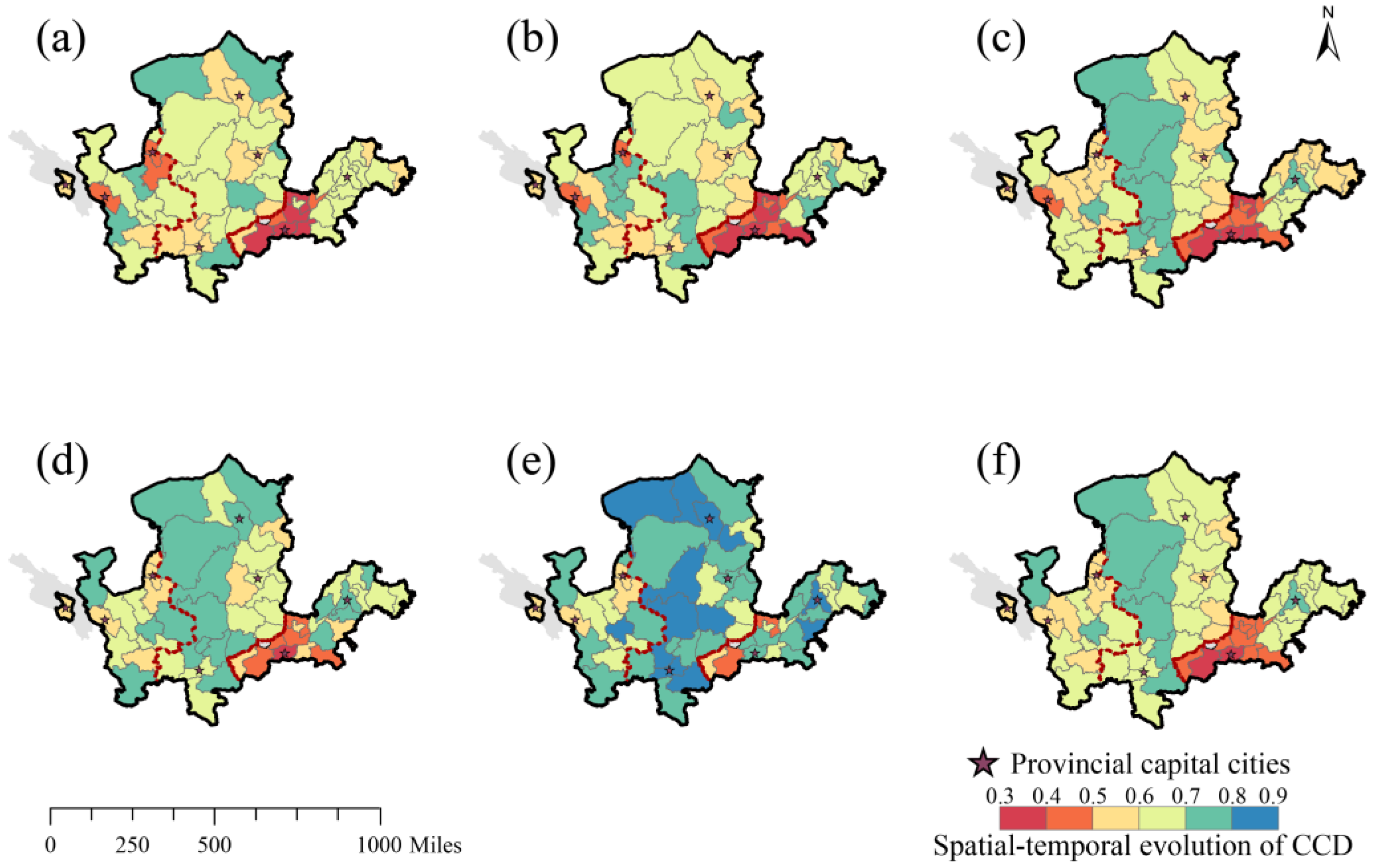
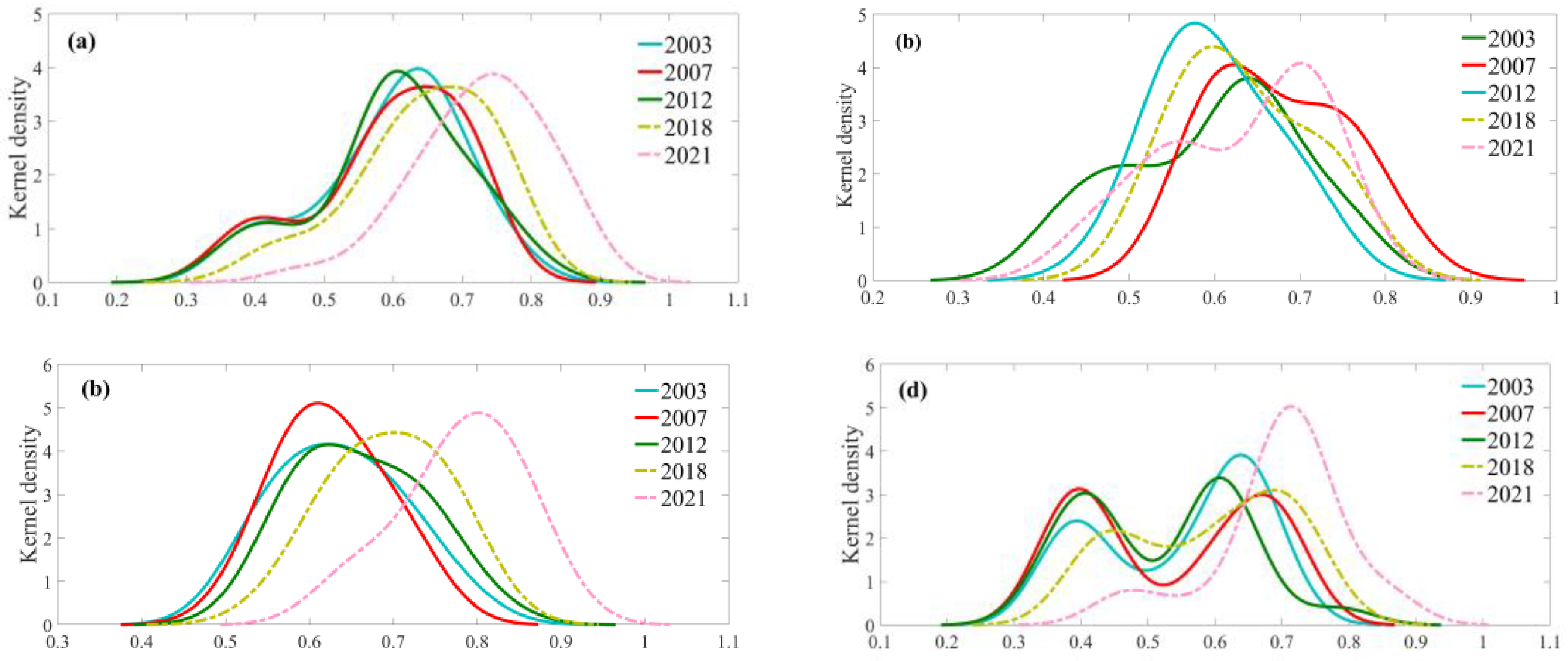
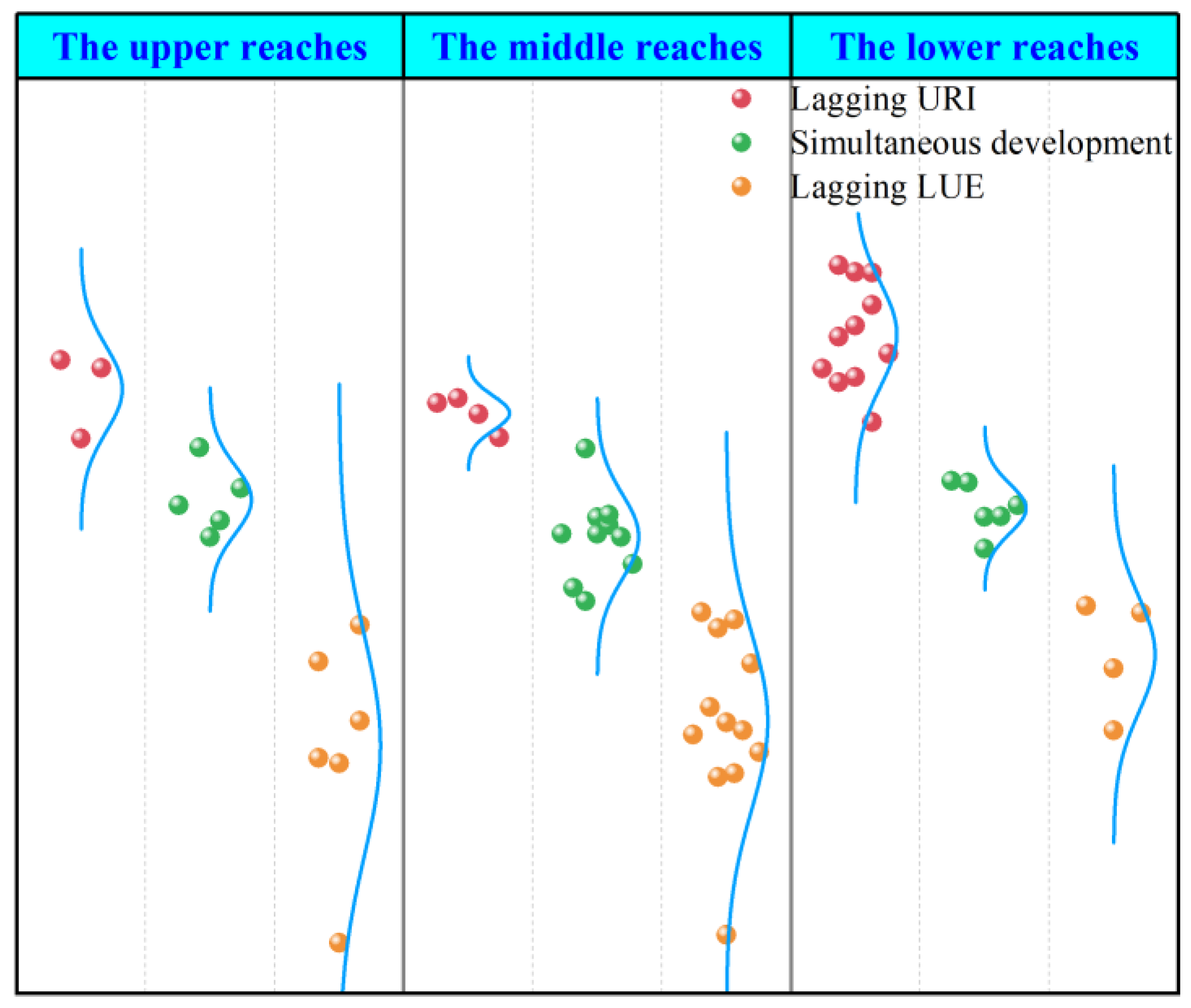
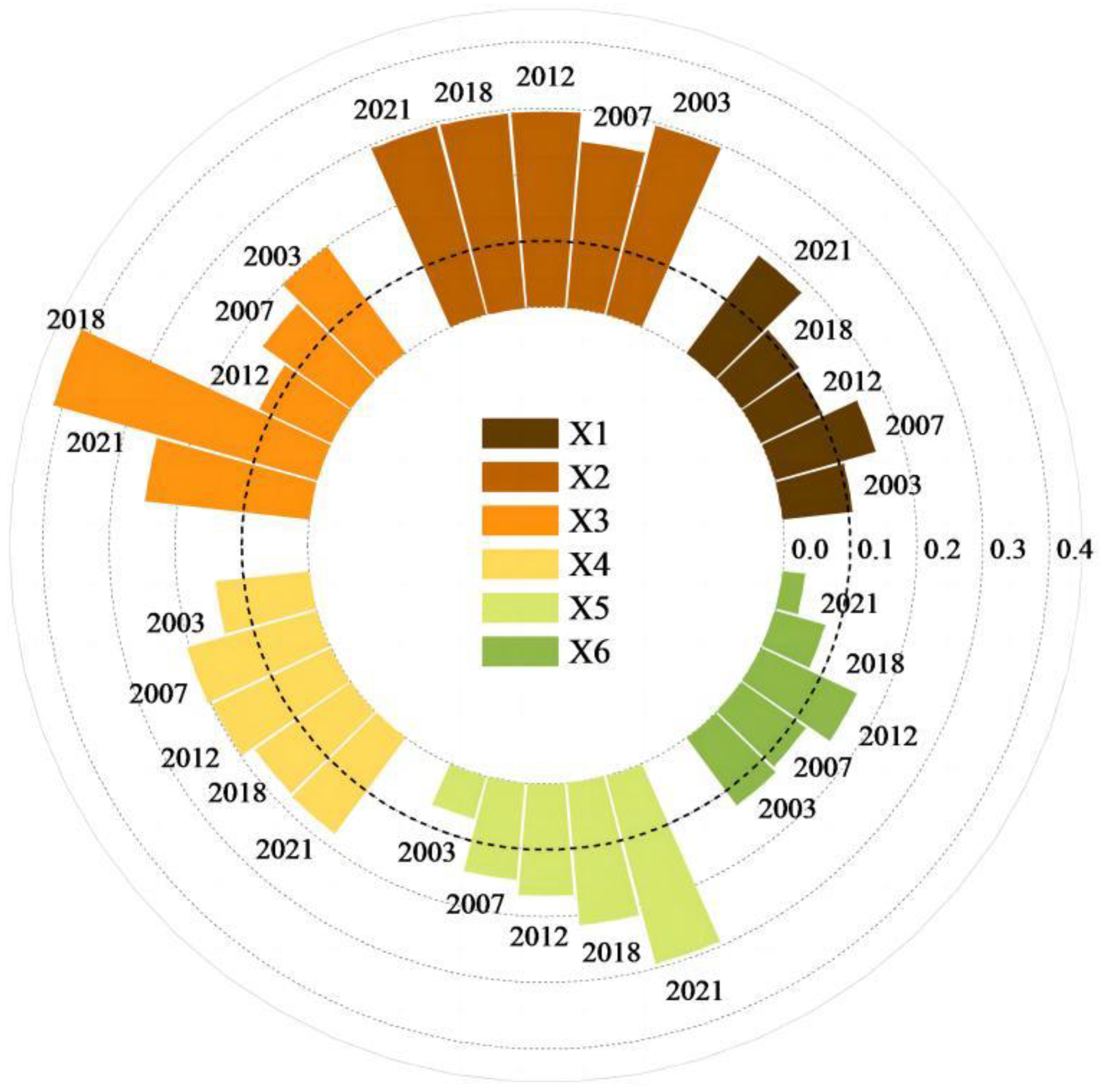
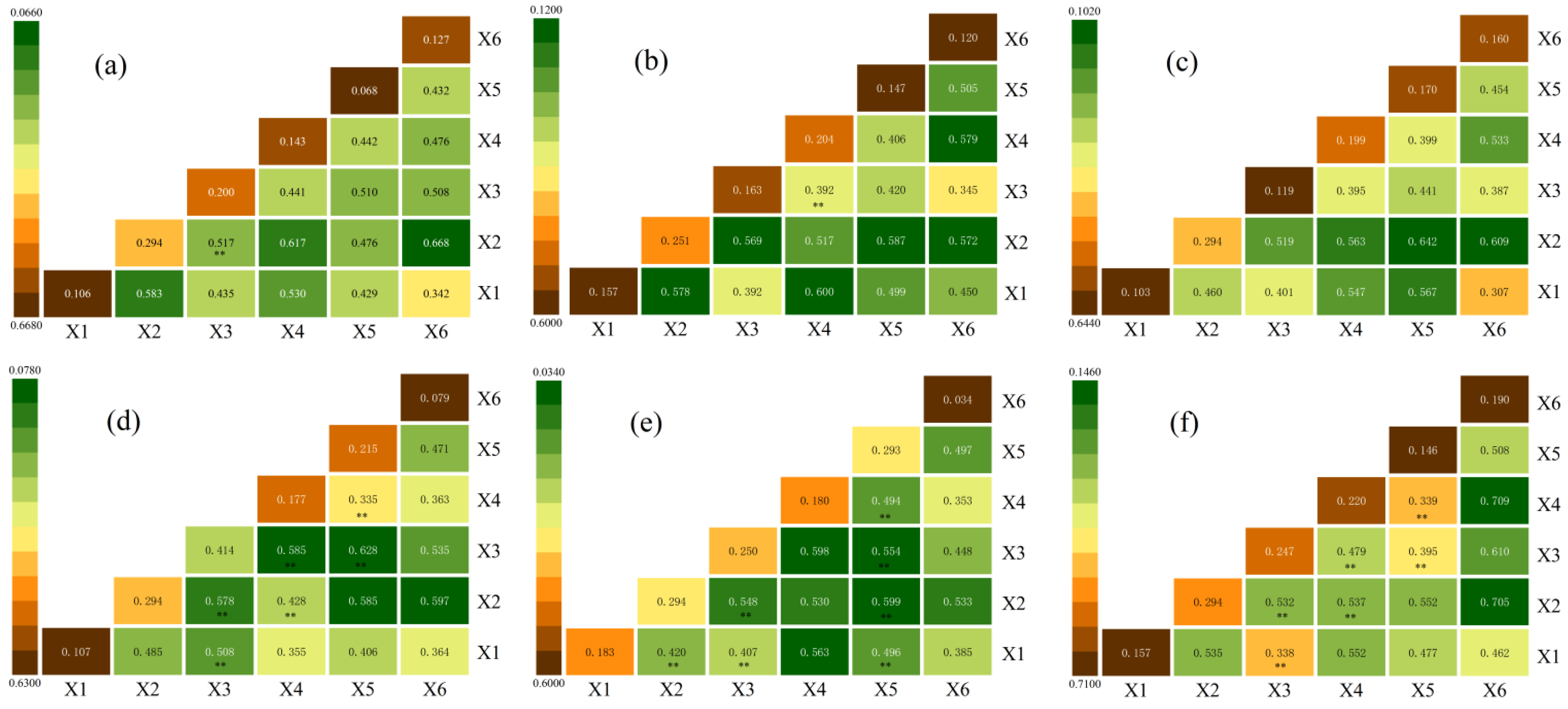
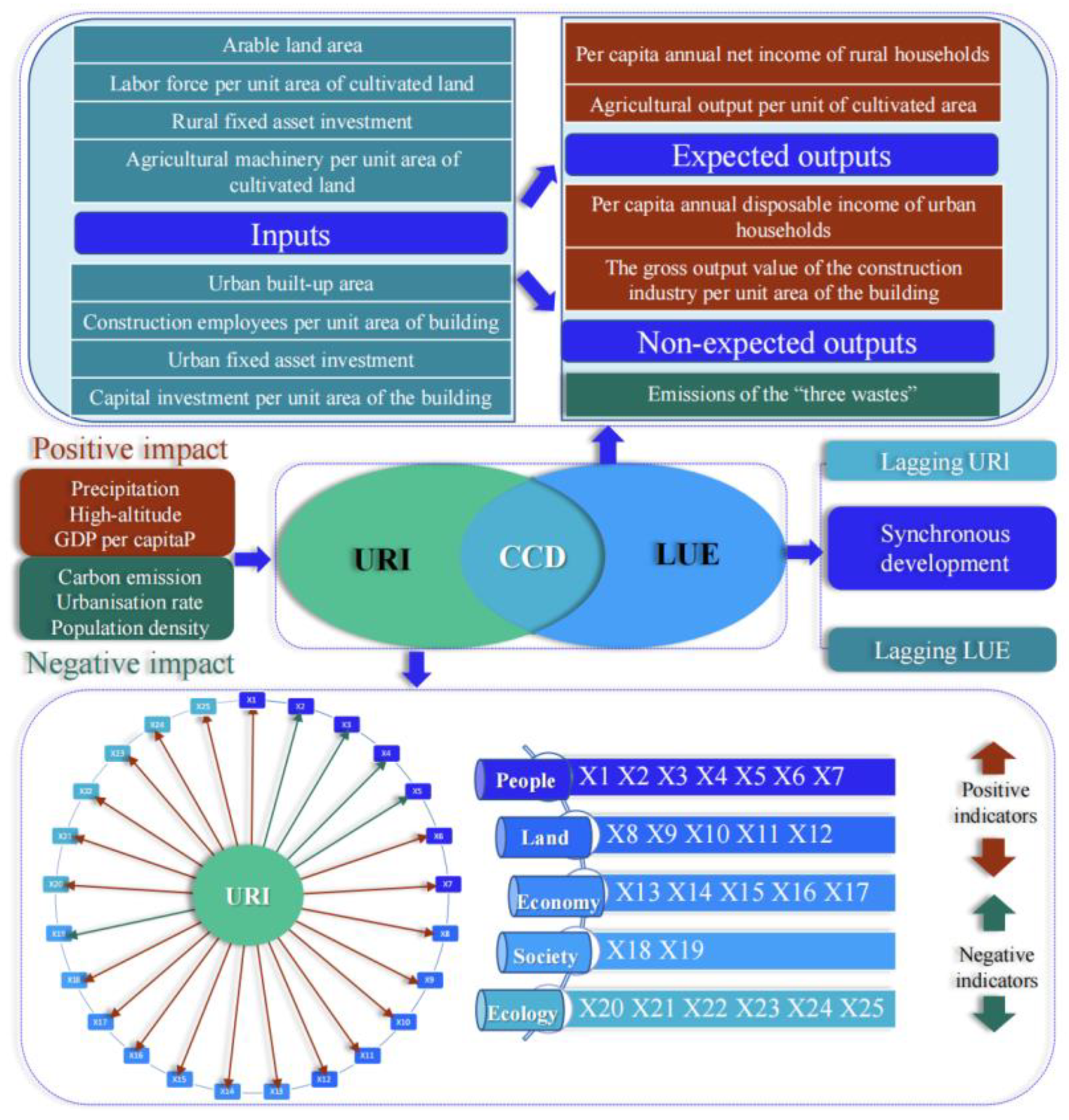
| Type | Date Presentation |
|---|---|
| Economic data | China Urban and Rural Construction Statistical Yearbook (2003–2021); Provincial Statistical Yearbook (2003–2021); EPSDATE (https://www.epsnet.com.cn), accessed on 30 April 2023. |
| Social data | Provincial Statistical Yearbook (2003–2021); EPSDATE (https://www.epsnet.com.cn), accessed on 30 April 2023. |
| Land data | China Urban Construction Statistical Yearbook (2003–2021); EPSDATE (https://www.epsnet.com.cn), accessed on 30 April 2023. |
| Ecological data | Carbon Emissions Accounts and Datasets, CEADs (https://www.ceads.net.cn); Multi-resolution Emission Inventory for China, MEIC (http://meicmodel.org.cn/); EPSDATE (https://www.epsnet.com.cn); accessed on 30 April 2023. |
| Climatic environmental data | Institute of Resource and Environmental Science and the Data Center of the Chinese Academy of Sciences (https://www.resdc.cn/), the resolution of elevation is 30 m, and the resolution of Precipitation is 1 km, accessed on 30 April 2023. |
| Index Dimensions | Index & Properties | Basic Index | Calculation or Description of the Index & Unit | Interpretation of the Index |
|---|---|---|---|---|
| People | X1 (+) | Population mobility rate | Urban population/total population (%) | Population mobility can positively impact the development of the rural economy, creating a beneficial urban–rural flow of people. |
| X2 (−) | Coefficient of contrast between urban and rural employment | Employment of urban households/employment of rural households | Reducing the gap between the incomes and consumption of urban–rural residents, particularly in food, culture, education, recreation, and daily electricity bills, will promote balanced incomes and consumption between urban–rural households. | |
| X3 (−) | The ratio of per capita annual disposable income of urban to rural residents | Per capita annual disposable income of urban households/per capita annual net income of rural households | ||
| X4 (−) | The ratio of per capita income of urban to rural residents | Per capita consumption of urban households/per capita consumption of rural households | ||
| X5 (−) | Comparison coefficient of culture, education, and entertainment between urban and rural areas | Urban residents’ household expenditure on culture, education, and entertainment/rural residents’ household expenditure on culture, education, and entertainment | ||
| X6 (+) | The ratio of Engel’s coefficients of urban to rural households | Engel’s coefficient of urban households/Engel’s coefficient of rural households | ||
| X7 (+) | The ratio of electricity consumption of urban to rural residents | Urban domestic electricity consumption/rural domestic consumer electricity consumption | ||
| Land | X8 (+) | The ratio of urban to rural residential space | Urban residential space/rural residential space | Reflect the allocation and utilization of land resources between urban and rural areas |
| X9 (+) | Urban spatial expansion | Built-up area/cropland area | ||
| X10 (+) | Land urbanization level | Built-up area/land area (%) | ||
| X11 (+) | Passenger turnover | Total passenger transportation (ten thousand people) | Reflect urban–rural accessibility, the greater the accessibility, the better the integration of urban–rural land. | |
| X12 (+) | Per capita postal and telecommunications services | Total postal and telecommunications services/total population (CNY/person) | ||
| Economy | X13 (+) | Regional economic operation condition | GDP per capita (CNY/person) | Under normal circumstances, regions with higher levels of economic development are more able to promote industry to feedback to agriculture and promote urban–rural integration development. |
| X14 (+) | Agriculture finance | Public expenditure on agriculture, forestry and water resource projects/financial expenditure (%) | Reflects the central and local financial input to rural areas, the greater the input, the more conducive the area is to the URI development. | |
| X15 (−) | Ratio of fixed asset investment in urban–rural areas | Rural fixed asset investment/urban fixed asset investment | Reflects the strength of investments in fixed assets in urban–rural regions, especially in infrastructure improvement and optimization of livelihood projects. | |
| X16 (+) | Binary comparison coefficient | (Output value of primary industry/employees in the primary industry)/(Output value of secondary and tertiary industries/employees in secondary and tertiary industries) | Reflects the difference in economic structure between the traditional agricultural sector and the modern industrial and service sectors; the smaller the industrial gap between urban and rural areas, the more conducive the areas are to promoting URI. | |
| X17 (+) | Agricultural mechanization level | Total power of agricultural machinery/arable land area (Kilowatt/hectares) | Agricultural modernization has a positive impact on rural economic development and URI. | |
| Society | X18 (+) | Internet penetration rate | Internet access in urban–rural areas/total number of urban–rural households (%) | Reflect urban–rural residents’ access to public services. |
| X19 (−) | The ratio of the level of medical protection for urban to rural residents | Hospital beds per 1000 population in urban healthcare institutions/hospital beds per 1000 population in rural healthcare institutions | ||
| Ecology | X20 (+) | Harmless treatment rate of domestic waste | % | Reflect the level of the living environment for urban–rural residents, harmless treatment of domestic rubbish and sewage treatment can improve the living conditions of residents, and optimize the urban–rural ecological environment which can improve the URI. |
| X21 (+) | Wastewater treatment | % | ||
| X22 (+) | Industrial sulfur dioxide emissions | Metric tons | Industrial pollution mainly affects the urban environment. | |
| X23 (+) | Industrial wastewater discharge | Metric tons | ||
| X24 (+) | Industrial solid waste emissions | Metric tons | ||
| X25 (+) | Ratio of investment in environmental pollution treatment | Investment in environmental pollution control/total output value (%) | Investment in pollution control represents the level of environmental pollution control, and a high level of control benefits URI. |
| Goal Layer | Criterion Layer | Urban Indicators | Rural Indicators | |
|---|---|---|---|---|
| Inputs | Land | Urban built-up area | Arable land area | |
| Labor force | Construction employees per unit area of building | Labor force per unit area of cultivated land | ||
| Energy | Urban residential space | Rural residential space | ||
| Capital investment per unit area of building | Agricultural machinery per unit area of cultivated land | |||
| Outputs | Expected outputs | Social benefit | Per capita annual disposable income of urban households | Per capita annual net income of rural households |
| Economic benefit | The gross output value of the construction industry per unit area of building | Agricultural output per unit of cultivated area | ||
| Non-expected Outputs | Emission reduction | Emissions of the “three wastes” (wastewater, waste gas, and industrial solid waste) | — | |
| CCD Level | Coupling Coordination Stages | Coupled Coordination Features |
|---|---|---|
| Moderate disorder | Lagging URI | |
| Synchronous development | ||
| Lagging LUE | ||
| Mild disorder | Lagging URI | |
| Synchronous development | ||
| Lagging LUE | ||
| General coordination | Lagging URI | |
| Synchronous development | ||
| Lagging LUE | ||
| Moderate coordination | Lagging URI | |
| Synchronous development | ||
| Lagging LUE | ||
| Good coordination | Lagging URI | |
| Synchronous development | ||
| Lagging LUE | ||
| Good quality coordination | Lagging URI | |
| Synchronous development | ||
| Lagging LUE |
| Variants | Regression Results | Standard Error | Values |
|---|---|---|---|
| Precipitation | 21.222 *** | −7.111 | 1159 |
| High-altitude | 0.023 *** | −0.004 | 1159 |
| Slope | 0.001 | −0.001 | 1159 |
| Carbon emissions | −0.033 *** | −0.007 | 1159 |
| GDP per capita | 0.038 *** | −0.004 | 1159 |
| Urbanization rate | −0.002 *** | 0.000 | 1159 |
| Population density | −0.049 *** | −0.003 | 1159 |
| Percentage of days with good air quality | −0.000 * | 0.000 | 1159 |
| Per capita arable land area | 0.001 | −0.001 | 1159 |
| The proportion of non-agricultural industries | 0.005 | −0.003 | 1159 |
| Constant | 0.791 *** | −0.077 |
Disclaimer/Publisher’s Note: The statements, opinions and data contained in all publications are solely those of the individual author(s) and contributor(s) and not of MDPI and/or the editor(s). MDPI and/or the editor(s) disclaim responsibility for any injury to people or property resulting from any ideas, methods, instructions or products referred to in the content. |
© 2023 by the authors. Licensee MDPI, Basel, Switzerland. This article is an open access article distributed under the terms and conditions of the Creative Commons Attribution (CC BY) license (https://creativecommons.org/licenses/by/4.0/).
Share and Cite
Shen, C.; Shi, L.; Wu, X.; Ding, J.; Wen, Q. Exploring the Coupling Coordination and Key Factors between Urban–Rural Integrated Development and Land-Use Efficiency in the Yellow River Basin. Land 2023, 12, 1583. https://doi.org/10.3390/land12081583
Shen C, Shi L, Wu X, Ding J, Wen Q. Exploring the Coupling Coordination and Key Factors between Urban–Rural Integrated Development and Land-Use Efficiency in the Yellow River Basin. Land. 2023; 12(8):1583. https://doi.org/10.3390/land12081583
Chicago/Turabian StyleShen, Caiting, Linna Shi, Xinyan Wu, Jinmei Ding, and Qi Wen. 2023. "Exploring the Coupling Coordination and Key Factors between Urban–Rural Integrated Development and Land-Use Efficiency in the Yellow River Basin" Land 12, no. 8: 1583. https://doi.org/10.3390/land12081583
APA StyleShen, C., Shi, L., Wu, X., Ding, J., & Wen, Q. (2023). Exploring the Coupling Coordination and Key Factors between Urban–Rural Integrated Development and Land-Use Efficiency in the Yellow River Basin. Land, 12(8), 1583. https://doi.org/10.3390/land12081583









